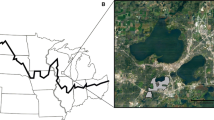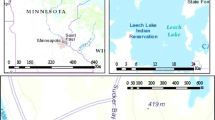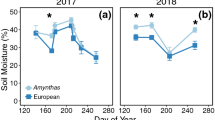Abstract
Effects of invasive European earthworms in North America have been well documented, but less is known about ecological consequences of exotic Asian earthworm invasion, in particular Asian jumping worms (Amynthas) that are increasingly reported. Most earthworm invasion research has focused on forests; some Amynthas spp. are native to Asian grasslands and may thrive in prairies with unknown effects. We conducted an earthworm-addition mesocosm experiment with before–after control-impact (BACI) design and a complementary field study in southern Wisconsin, USA, in 2014 to investigate effects of a newly discovered invasion of two Asian jumping worms (Amynthas agrestis and Amynthas tokioensis) on forest and prairie litter and soil nutrient pools. In both studies, A. agrestis and A. tokioensis substantially reduced surface litter (84–95 % decline in foliage litter mass) and increased total carbon, total nitrogen, and available phosphorus in the upper 0–5 cm of soils over the 4-month period from July through October. Soil inorganic nitrogen (ammonium– and nitrate–N) concentration increased across soil depths of 0–25 cm, with greater effects on nitrate–N. Dissolved organic carbon concentration also increased, e.g., 71–108 % increase in the mesocosm experiment. Effects were observed in both forest and prairie soils, with stronger effects in forests. Effects were most pronounced late in the growing season when earthworm biomass likely peaked. Depletion of the litter layer and rapid mineralization of nutrients by non-native Asian jumping worms may make ecosystems more susceptible to nutrient losses, and effects may cascade to understory herbs and other soil biota.







Similar content being viewed by others
References
Alban DH, Berry EC (1994) Effects of earthworm invasion on morphology, carbon, and nitrogen of a forest soil. Appl Soil Ecol 1:243–249
Balser TC, Firestone MK (2005) Linking microbial community composition and soil processes in a California annual grassland and mixed-conifer forest. Biogeochemistry 73:395–415
Bates D, Maechler M, Bolker B (2015) Linear mixed-effects models using Eigen and S4. R package version 1.1–7. http://cran.r-project.org/web/packages/lme4/index.html. Accessed 6 April 2015
Belliturk K, Gorres JH, Kunkle J, Melnichuk RDS (2015) Can commercial mulches be reservoirs of invasive earthworms? Promotion of ligninolytic enzyme activity and survival of Amynthas agrestis (Goto and Hatai 1899). Appl Soil Ecol 87:27–31
Blouin M, Hodson ME, Delgado EA, Baker G, Brussaard L, Butt KR, Dai J, Dendooven L, Pérès G, Tondoh J (2013) A review of earthworm impact on soil function and ecosystem services. Eur J Soil Sci 64:161–182
Bohlen PJ, Groffman PM, Fahey TJ, Fisk MC, Suarez E, Pelletier DM, Fahey RT (2004a) Ecosystem consequences of exotic earthworm invasion of north temperate forests. Ecosystems 7:1–12
Bohlen PJ, Pelletier DM, Groffman PM, Fahey TJ, Fisk MC (2004b) Influence of earthworm invasion on redistribution and retention of soil carbon and nitrogen in northern temperate forests. Ecosystems 7:13–27
Bohlen PJ, Scheu S, Hale CM, McLean MA, Migge S, Groffman PM, Parkinson D (2004c) Non-native invasive earthworms as agents of change in northern temperate forests. Front Ecol Environ 2:427–435
Bray RH, Kurtz L (1945) Determination of total, organic, and available forms of phosphorus in soils. Soil Sci 59:39–46
Burtelow AE, Bohlen PJ, Groffman PM (1998) Influence of exotic earthworm invasion on soil organic matter, microbial biomass and denitrification potential in forest soils of the northeastern United States. Appl Soil Ecol 9:197–202
Callaham MA, Hendrix PF, Phillips RJ (2003) Occurrence of an exotic earthworm (Amynthas agrestis) in undisturbed soils of the southern Appalachian Mountains, USA. Pedobiologia 47:466–470
Costello DM, Lamberti GA (2009) Biological and physical effects of non-native earthworms on nitrogen cycling in riparian soils. Soil Biol Biochem 41:2230–2235
Crumsey JM, Le Moine JM, Capowiez Y, Goodsitt MM, Larson SC, Kling GW, Nadelhoffer KJ (2013) Community-specific impacts of exotic earthworm invasions on soil carbon dynamics in a sandy temperate forest. Ecology 94:2827–2837
Currie WS, Aber JD (1997) Modeling leaching as a decomposition process in humid Montane forests. Ecology 78:1844–1860
Dominguez J, Bohlen PJ, Parmelee RW (2004) Earthworms increase nitrogen leaching to greater soil depths in row crop agroecosystems. Ecosystems 7:672–685
Edwards CA (2004) Earthworm ecology. CRC Press, Boca Raton
Eisenhauer N, Partsch S, Parkinson D, Scheu S (2007) Invasion of a deciduous forest by earthworms: changes in soil chemistry, microarthropds and vegetation. Soil Biol Biochem 39:1099–1110
Fahey TJ, Yavitt JB, Sherman RE, Maerz JC, Groffman PM, Fisk MC, Bohlen PJ (2013) Earthworm effects on the incorporation of litter C and N into soil organic matter in a sugar maple forest. Ecol Appl 23:1185–1201
Gates GE (1982) Farewell to North American megadriles. Megadrilogica 4:12–77
Greiner HG, Costello DM, Tiegs SD (2010) Allometric estimation of earthworm ash-free dry mass from diameters and lengths of select megascolecid and lumbricid species. Pedobiologia 53:247–252
Greiner HG, Kashian DR, Tiegs SD (2012) Impacts of invasive Asian (Amynthas hilgendorfi) and European (Lumbricus rubellus) earthworms in a North American temperate deciduous forest. Biol Invasions 14:2017–2027
Groffman PM, Bohlen PJ, Fisk MC, Fahey TJ (2004) Exotic earthworm invasion and microbial biomass in temperate forest soils. Ecosystems 7:45–54
Hale CM (2007) Earthworms of the great lakes. Kollath-Stensaas, Duluth
Hale CM, Frelich LE, Reich PB, Pastor J (2008) Exotic earthworm effects on hardwood forest floor, nutrient availability and native plants: a mesocosm study. Oecologia 155:509–518
Hendrix PF, Callaham MA, Drake JM, Huang CY, James SW, Snyder BA, Zhang WX (2008) Pandora’s box contained bait: the global problem of introduced earthworms. Annu Rev Ecol Syst 39:593–613
Hothorn T, Bretz F, Westfall P (2008) Simultaneous inference in general parametric models. Biometrical J 50:346–363
Ikeda H, Callaham MA, O’Brien JJ, Hornsby BS, Wenk ES (2015) Can the invasive earthworm, Amynthas agrestis, be controlled with prescribed fire? Soil Biol Biochem 82:21–27
Ishizuka K (2001) Taxanomic study of the genus Pheretima s. lat. (Oligochaeta, Megasolecidae) from Japan. B Seikei Univ 33:1–125
Ishizuka K, Minagoshi F (2014) Pictorial book of earthworm. Zenkoku Noson Kyoiku Kyokai Co., Ltd., Tokyo (In Janpanese)
James SW (1995) Systematics, biogeography, and ecology of Nearctic earthworms from eastern, central, southern, and southwestern United States. In: Hendrix P (ed) Earthworm ecology and biogeography in North America. Lewis Publishers, Boca Raton, pp 29–52
Kalbitz K, Solinger S, Park JH, Michalzik B, Matzner E (2000) Controls on the dynamics of dissolved organic matter in soils: a review. Soil Sci 165:277–304
Kuznetsova A, Brockhoff PB, Christensen RHB (2014) lmerTest: tests for random and fixed effects for linear mixed effect models (lmer objects of lme4 package). R package version 2.0–6. http://cran.r-project.org/web/packages/lmerTest/index.html. Accessed 6 April 2015
Lavelle P, Decaens T, Aubert M, Barot S, Blouin M, Bureau F, Margerie P, Mora P, Rossi JP (2006) Soil invertebrates and ecosystem services. Eur J Soil Biol 42:S3–S15
Lubbers IM, Brussaard L, Otten W, van Groenigen JW (2011) Earthworm-induced N mineralization in fertilized grassland increases both N2O emission and crop-N uptake. Eur J Soil Sci 62:152–161
Masamichi T, Masatoshi Y, Fumio Y (2011) Earthworm fauna (Annelida: Clitellata) of the main campus and Chiyoda experimental station of Forestry and Forest Products Research Institute. B FFPRI 4:281–289
McLean MA, Migge-Kleian S, Parkinson D (2006) Earthworm invasions of ecosystems devoid of earthworms: effects on soil microbes. Biol Invasions 8:1257–1273
R Development Core Team (2009) R A language and environment for statistical computing. http://www.R-project.org
Resner K, Yoo K, Sebestyen SD, Aufdenkampe A, Hale C, Lyttle A, Blum A (2015) Invasive earthworms deplete key soil inorganic nutrients (Ca, Mg, K, and P) in a northern hardwood forest. Ecosystems 18:89–102
Reynolds JW, Wetzel MJ (2012) Terrestrial Oligochaeta (Annelida: Clitellata) in North America, including Mexico, Puerto Rico, Hawaii, and Bermuda. III. Megadrilogica 15:191–211
Richardson DR, Snyder BA, Hendrix PF (2009) Soil moisture and temperature: tolerances and optima for a non-native earthworm species, Amynthas agrestis (Oligochaeta: Opisthopora: Megascolecidae). Southeast Nat 8:325–334
Richardson JB, Gorres JH, Friedland AJ (2016) Forest floor decomposition, metal exchangeability, and metal bioaccumulation by exotic earthworms: Amynthas agrestis and Lumbricus rubellus. Environ Sci Pollut Res. doi:10.1007/s11356-016-6994-5
Robertson GP, Sollins P, Ellis BG, Lajtha K (1999) Exchangeable ions, pH, and cation exchange capacity. In: Robertson GP, Biedsoe CS, Coleman DC, Sollins P (eds) Standard soil methods for long-term ecological research. Oxford University Press, New York, pp 106–114
Sackett TE, Smith SM, Basiliko N (2013) Indirect and direct effects of exotic earthworms on soil nutrient and carbon pools in North American temperate forests. Soil Biol Biochem 57:459–467
Samson F, Knopf F (1994) Prairie conservation in North America. Bioscience 44:418–421
Scheu S, Parkinson D (1994) Effects of earthworms on nutrient dynamics, carbon turnover and microorganisms in soils from cool temperate forests of the Canadian Rocky Mountains—laboratory studies. Appl Soil Ecol 1:113–125
Snyder BA, Boots B, Hendrix PF (2009) Competition between invasive earthworms (Amynthas corticis, Megascolecidae) and native North American millipedes (Pseudopolydesmus erasus, Polydesmidae): effects on carbon cycling and soil structure. Soil Biol Biochem 41:1442–1449
Snyder BA, Callaham MA, Hendrix PF (2011) Spatial variability of an invasive earthworm (Amynthas agrestis) population and potential impacts on soil characteristics and millipedes in the Great Smoky Mountains National Park, USA. Biol Invasions 13:349–358
Snyder BA, Callaham MA, Lowe CN, Hendrix PF (2013) Earthworm invasion in North America: food resource competition affects native millipede survival and invasive earthworm reproduction. Soil Biol Biochem 57:212–216
Speratti AB, Whalen JK (2008) Carbon dioxide and nitrous oxide fluxes from soil as influenced by anecic and endogeic earthworms. Appl Soil Ecol 38:27–33
Suarez ER, Pelletier DM, Fahey TJ, Groffman PM, Bohlen PJ, Fisk MC (2004) Effects of exotic earthworms on soil phosphorus cycling in two broadleaf temperate forests. Ecosystems 7:28–44
Suarez ER, Fahey TJ, Yavitt JB, Groffman PM, Bohlen PJ (2006) Patterns of litter disappearance in a northern hardwood forest invaded by exotic earthworms. Ecol Appl 16:154–165
Szlavecz K, Placella SA, Pouyat RV, Groffman PM, Csuzdi C, Yesilonis I (2006) Invasive earthworm species and nitrogen cycling in remnant forest patches. Appl Soil Ecol 32:54–62
Tipping E, Woof C, Rigg E, Harrison AF, Ineson P, Taylor K, Benham D, Poskitt J, Rowland AP, Bol R, Harkness DD (1999) Climatic influences on the leaching of dissolved organic matter from upland UK Moorland soils, investigated by a field manipulation experiment. Environ Int 25:83–95
Uchida T (2004) Feeding strategies of earthworms (Megascolecidae Oligochaeta) in Japan. Jpn J Ecol:235–243 (in Japanese)
Uchida T, Kaneko N, Ito MT, Futagami K, Sasaki T, Sugimoto A (2004) Anlaysis of the feeding ecology of earthworms (Megascolecidae) in Janpanese forests using gut content fraction and δ15 N and δ13 C stable isotope natural abundance. Appl Soil Ecol 27:153–163
Underwood AJ (1994) On beyond BACI: sampling designs that might reliably detect environmental disturbances. Ecol Appl 4:3–15
Vickers AJ (2001) The use of percentage change from baseline as an outcome in a controlled trial is statistically inefficient: a simulation study. BMC Med Res Methodol 1:6
Werling BP, Dickson TL, Isaacs R, Gaines H, Gratton C, Gross KL, Liere H, Malmstrom CM, Meehan TD, Ruan L, Robertson BA, Robertson GP, Schmidt TM, Schrotenboer AC, Teal TK, Wilson JK, Landis DA (2014) Pereenail grasslands enhance bidoversity and multiple ecosystme services in bioenergy landscapes. P Natl Acad Sci USA 111:1652–1657
Wiltshire G, Laubscher D (1989) Economical manual estimation of ammonium, nitrate and total inorganic nitrogen in soils. S Afr J Plant Soil 6:53–58
Zhang WX, Hendrix PF, Snyder BA, Molina M, Li JX, Rao XQ, Siemann E, Fu SL (2010) Dietary flexibility aids Asian earthworm invasion in North American forests. Ecology 91:2070–2079
Zhang WX, Hendrix PF, Dame LE, Burke RA, Wu JP, Neher DA, Li JX, Shao YH, Fu SL (2013) Earthworms facilitate carbon sequestration through unequal amplification of carbon stabilization compared with mineralization. Nat Commun 4. doi:10.1038/ncomms3576
Acknowledgments
We thank Chris Kucharik, Steve Carpenter, Randy Jackson, and Timothy Whitby for help with the experimental design of this research. We appreciate logistical support from Susan Carpenter and Bradley Herrick, and thank the University of Wisconsin–Madison Arboretum for providing the field facility. We thank Jeffrey Hatzel, Allison Lobue, Eric Booth, Hannah Friedrick, Sam Zipper, Melissa Motew and Jason Schatz for field assistance, and Lawrence Oates, Liz Runde and Jane Remfert for help with laboratory analyses. Susan Carpenter, Carly Ziter, Bradley Herrick and two anonymous reviewers provided helpful feedback on earlier versions of the manuscript. Funding was provided by the National Science Foundation under Grant DEB-1038759 and Northern Temperate Lakes Long-Term Ecological Research under grant DEB-1440297.
Author information
Authors and Affiliations
Corresponding author
Electronic supplementary material
Below is the link to the electronic supplementary material.
Rights and permissions
About this article
Cite this article
Qiu, J., Turner, M.G. Effects of non-native Asian earthworm invasion on temperate forest and prairie soils in the Midwestern US. Biol Invasions 19, 73–88 (2017). https://doi.org/10.1007/s10530-016-1264-5
Received:
Accepted:
Published:
Issue Date:
DOI: https://doi.org/10.1007/s10530-016-1264-5




